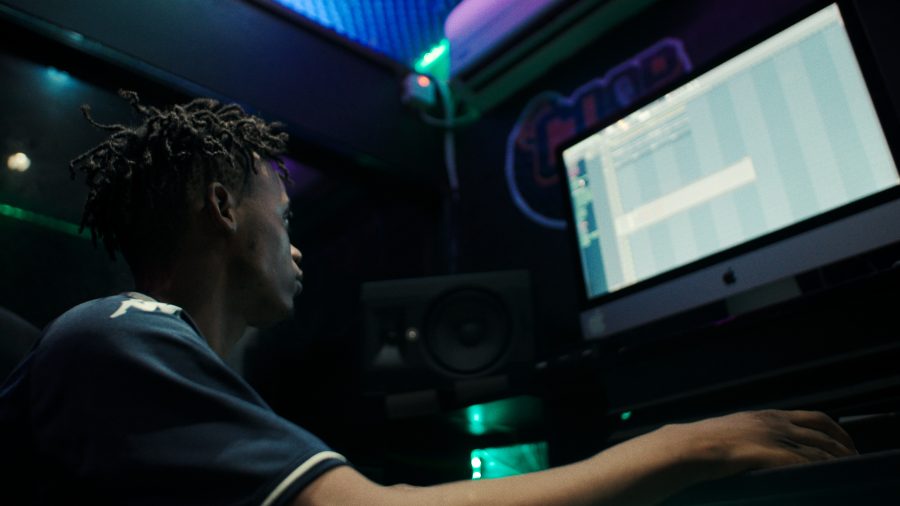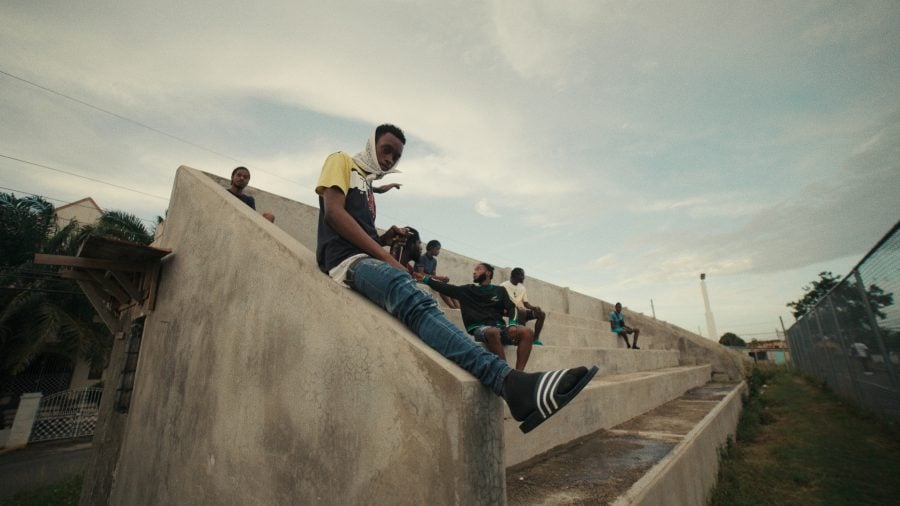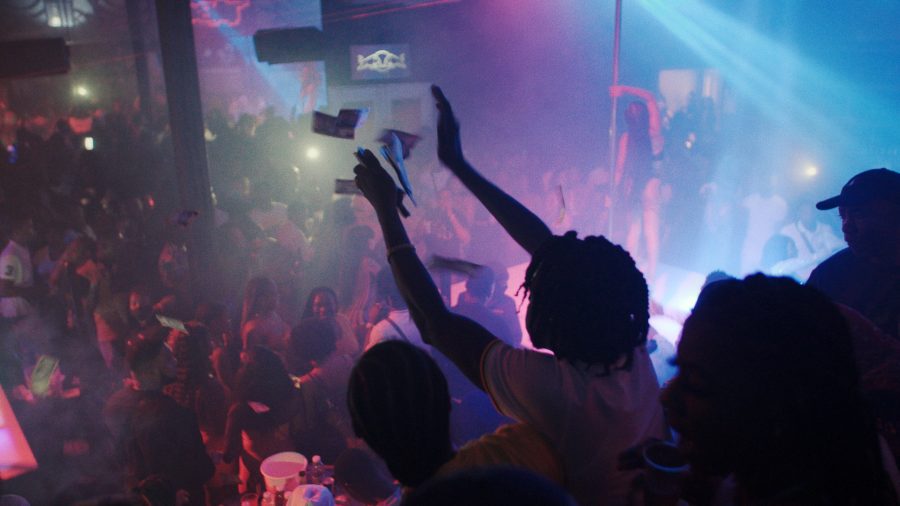Interview: UK Filmmaker Nathan Miller Opens The ‘Trap’ On Dancehall’s New Generation
Much to the alarm of its opponents, Trap Dancehall seems to be here to stay – at least until a new youth-driven sound arrives to replace it. A recent radio embargo against music in Jamaica that “promotes and/or glorifies illegal activity” has done little, if anything, to dissuade artists from pushing tales of scamming, violence, and drugs over booming 808s. And with the genre’s stars like Skeng and Skillibeng increasing their foothold in foreign markets, critics at home are left to brood from a distance.
Against the backdrop of this tension, East London-based filmmaker Nathan Miller traveled across Jamaica for three weeks, armed with video equipment and a few questions, chief among them: How do Trap Dancehall’s pioneers view their rise and the subsequent backlash?
The result is God Bless You, My Son, a fifteen-minute documentary, fuelled by interviews with nearly twenty of Trap Dancehall’s architects and ambassadors. Govana, Brysco, and Iwaata are among several who provide commentary, both on their personal histories and on the latest chapter in Jamaica’s street music. The incendiary lyrics at the heart of the national firestorm are frequently discussed.
God Bless You, My Son is the fourth film that Nathan Miller has made, which documents a regional sound and the artists within its orbit. His first, released in 2015, was Prologue , which explored three artists coming up in the rap and grime scene in his native London. He expanded this concept in 2017 with the feature-length documentary LDN , and presented a similar treatment of the hip-hop artists of Toronto with his film North Side , released that same year.
Since then, his portfolio has grown considerably and now boasts video work commissioned by Drake’s OVO brand. One of these commercials features Skeng.
Originally planned to be an hour long, the final version of God Bless You, My Son ended up being far more concise. As with his other documentaries, Nathan Miller is guided by sympathy for his subjects, and as a result, his film provides a rare glimpse into a world barely understood by most. It serves as a necessary step in bridging that widening gulf between generations.
Nathan Miller recently spoke at length with DancehallMag about his experience putting the documentary together.
What was your exposure to Jamaican culture like growing up in East London?
My exposure to Jamaican culture dates back to being born. My granddad is first generation [in England] — he was born in Jamaica. And then my dad was very heavy into sound systems. Growing up, I was listening to King Addies, Bass Odyssey, and Black Cat — all these different sound systems that maybe I shouldn’t have known about at that age.
I’ve got some family from Grenada too, but I just found that because most of my family is from Jamaica, I gravitated more towards that culture. And then Jamaica’s a powerhouse when it comes to trends in music, food, and dancing. I’ve always gone through phases of what I’m interested in, but Dancehall is kinda the one thing that’s always remained the same for me.
How did you come to the concept for the film?
There were three things that made me want to shoot this piece. The first was that, in my opinion, it’s something that’s been untapped and hasn’t really been explored in recent times. The second thing was that I was frustrated creatively with having a lot of documentary projects in the works for such a long time, and I’m still not sure if they’ll see the light of day.
The third thing really took me over the edge. In one of the last conversations I had with my Uncle Tony, he was just saying keep up the good work on the film. He fell ill shortly after that conversation and subsequently passed away. And so a combination of all these things made me say let’s go out to Jamaica. Let’s make it happen.
I guess another thing is that there’s not much modern coverage of Jamaica — from a film standpoint. When I was trying to do my research on Jamaican films it would always lead me to [Hype Williams’s] Belly or [Perry Henzell’s] The Harder They Come. I was finding reference images from the 90s and I just felt like the database is kinda dated. I felt like it was overdue for there to be a new look at Jamaica.
What was it like coordinating a film to be shot nearly 5,000 miles away?
Yeah, that was a task. So at the end of 2021, I had the idea to do it. So I created a list, sent out a bunch of emails, went to sleep, and thankfully I woke up to a couple of responses.
The beauty of it is that some artist’s managers tend to be based in the U.K., and around that time, Govana and Skeng were having a show coming up in the U.K. So I was able to make that connection before travelling out to Jamaica.
https://www.instagram.com/p/Ckd4LMLIpeU/
And once you get one person, it makes it easier to get everybody else. So it makes it ten times easier when you’ve already got footage of this person. When Govana and Skeng came to the U.K., that was sort of the start of filming and building that rapport.
Aside from that, it was kinda difficult because of the time difference and that kind of laidback vibe at the core of Jamaica. I remember the first time I went to Jamaica, I was walking and my cousin just said, Slow down, you’re walking too fast! We don’t move like that. We walk slowly here. So I’d say that was a blessing and a curse sometimes.
What were some of the lessons you’d wanted to apply to this film from your time documenting the music scenes in London and Toronto?
I think I just really wanted the film to be appreciated from a cinematic standpoint. I wanted people to look at it and see how my experience from the years that I’ve put in translates to my work in Jamaica. A lot of what I’d planned didn’t actually happen. In a way, this is a result of making the best out of a bad situation, cause the film was originally intended to be an hour long.
In a way, it was crafting the story through the interviews that I’d done and finding the common themes within the answers to then create the strands for the film. When I’m interviewing a lot of people, I tend to ask them similar questions. And if one person says the same thing that everybody else has said, it’s usually a good sign for something to latch onto and say, ok, we should probably focus on this.

The planning was really in-depth. I knew what songs I wanted to hear, what artists I wanted to hear from, and I knew when they were gonna come in. But what the people don’t see is when that doesn’t happen. And this film is the result of a lot of the stuff not even happening — of gaps. There’s a whole other side to the film that could be explored.
Did the film have a working title before you decided to use the “God bless you, my son” quote from the interview?
Nah, in London, they’d just be like how’s that Jamaica project going? Finding that title was really cool because the titles of my previous stuff are quite on-the-nose: LDN is called that because it was shot in London; Northside is another term for Toronto. So I didn’t wanna go down that route of calling this one “Yaad” or anything like that.
It was nice because the title came from my favourite quote in the film — throughout all the footage. It sort of encapsulated the whole message of the film. Also, I like it because it isn’t until people watch the film that they’re like ok, I get why he called it that.
How much of a challenge was it alternating between the roles of director, camera operator, and sound recordist?
So I was accompanied by my friend Anthony [Williams], who has a co-directing credit on the film. He’s a great director in his own right. This film was a reunion of sorts because we worked together on LDN. And so shooting duties were between me and him. If I wasn’t filming, he would be.
Also, because of how the equipment is now, all we had to do was mic up the talent, put the camera down, find a nice frame, conduct the interview, and then shoot the cutaways. So it was very straightforward. I think it’s easier to do things now with minimal crew and with minimal resources. I think the basis of documentaries is just finding a good story and just telling it to the best of your ability with what you have.
I’d say the difficulty of this film was with liaising with the artists and finding a time and place to do it. I didn’t hear back from some artists. Some were really responsive, and some said we had it do it quickly. There were others who had to interview on the fly. So in terms of difficulty, it really came down to availability for the artists.

Some of it fell on us because when we arrived, we were very laid back. We were getting things done, but I think we probably should have been a bit more assertive with people that we were trying to connect with and just saying, hey, we’re on our way. Where should we head to? We took that approach later in the process and I think that probably would’ve helped if we began like that.
There are a lot of slow-motion shots and static compositions here, which is an interesting creative choice considering that Dancehall culture is typically associated with this fast-paced, high-octane energy. The film ended up feeling a bit meditative as a result.
For one, slow motion allows you to fill the screen longer, so I’ve found that cutaway shots provide a good safety net in case you don’t have everything you need. Aside from that, it really allowed people to appreciate the beauty of Jamaica and not get too caught up with what people tend to see, like the fast-paced action of the city. I wanted people to see portraits of these moments rather than glimpses of them.
As I said, one of the references for the film was Belly and it features a cool scene where DMX and those guys are going into a dance [in Kingston]. That was shot in slow-mo and I remember watching that back and just being like, this place looks so cool. I knew I wanted to shoot a part in slow-mo, but then it just so happened that most of the film ended up being shot that way.
You credited everyone involved in the film at the end, but I noticed that during the voice-over, the narration switches from one person to another without any indication of who’s talking. What was the thinking there?
The initial plan for the film was to go off into individual stories with these artists. So spend more time with them, kind of having them show us around, getting more interview-to-camera stuff. But when I created that edit, that’s where the crack started to form with what I hadn’t shot.
What I resorted to doing was, rather than have the story be told by individuals driving it, let me try to connect them all together. I felt like a lot of people were saying the same things. It just felt right to have certain people speak on behalf of the current wave of Dancehall as opposed to lining up and saying, this person said this, this person that and so on. Though that was the original intention.
On top of that, there were about 18 people whose voices were used, so it would’ve become overbearing to see a name title every couple of seconds, in addition to the subtitles. It ended up having the effect of this being the voice of what’s happening right now. I angled it so everyone kind of speaks in agreement with each other. Everyone’s complementing what each other is saying.
Skeng pops up a few times but doesn’t speak. Did you interview him for the film?
I interviewed him candidly, like impromptu stuff. But that was in London. I didn’t get a chance to do a formal interview with him in Jamaica, though that was the plan. I think it all just boiled down to a miscommunication. There were soundbites I could’ve used, but I chose not to.
But it added a different angle when his dad gave that interview. I thought that was an interesting note to end things on, given the film’s message about supporting the younger generation. Did you make that decision during editing?
Yeah, it just worked out that way. Skeng’s dad was there helping out with the show in London and I’m someone who, if there’s a moment to talk, I’ll just start talking.
So I just began talking to him about Skeng’s success. The interview didn’t last longer than two minutes. But I think it really captured what the film set out to do in terms of humanizing these artists as opposed to having them be looked at as like celebrities and stars — which a lot of them are. But at the core of it, everyone has a mom and a dad. And just hearing a man talk about the pride he has for his son, I felt like it was quite strong.

And it was showing because I knew this film was going to appeal to not only fans of Trap-Dancehall and Dancehall, but the older generation as well.
Overall, what did you find to be the most striking thing about your time in Jamaica?
Hands down the food. But also the hospitality of Jamaicans. I’ll tell you the truth — when I initially said I wanted to do this film, many Jamaicans abroad had this view of the island just based on the crime. If you have family in Jamaica, it’s very easy to draw for that as opposed to talking about the blessings and the good things of it.
When I was gearing up to shoot this film, many of the people who I was interacting with, like the artist’s managers, were saying You’re gonna love it. They kept telling me don’t worry about what I’m seeing online and all that stuff.
And when I got there, it was nice to experience it in its full glory, and my judgment was that you get from Jamaica what you give to it. If you come with good vibes and a good attitude, you’re gonna have a great time.
